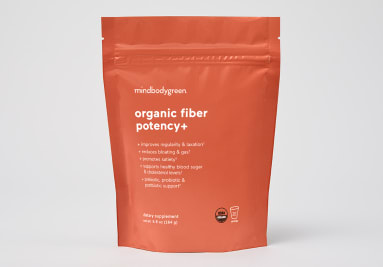The 7 Best Prebiotic Foods To Nourish Your Gut


With the booming recognition of all things gut health, words like probiotics, prebiotics, synbiotics, and postbiotics (oh boy!) are thrown around like we all have an advanced degree in microbiology. And while we may recognize words ending in biotics as relating to the gut microbiome, each one is distinctly different.
We're going to dive into what you need to know about prebiotics and the foods that contain the highest amount of these beneficial fibers.
What are prebiotics?
Prebiotics refer to a specific type of fiber that only beneficial microorganisms in the gut (like bacteria and yeasts) are able to ferment or feed on. That's right, bacteria species that are deemed problematic to health aren't able to join in on the feast.
Therefore, prebiotics help improve the balance of good to bad bacteria1, contributing to a healthier gut microbiome as a whole.
What's more is that the fermentation process2 also produces nutrients like short-chain fatty acids or SCFAs (including butyrate) that help strengthen the gut lining3 and enhance immunity.
So, how do prebiotics differ from probiotics then? Probiotics are the beneficial live organisms in your gut (or ingested through fermented foods or supplements) and prebiotics act as the fertilizer that nourishes them.
Foods high in prebiotics
Now, not all fibrous foods are prebiotics. Only certain foods contain types of fiber that research shows meet the criteria outlined above. And most of the time, prebiotic fibers are also soluble fibers (meaning they swell and form a gel-like substance in the gut).
Prebiotics should be on the menu for everyone. But the foods that have the most prebiotics may surprise you—and may be lacking from your plate:
Chicory root
Chicory root is a woody, hardy herb. The prebiotic fiber inulin comprises an impressive 68% of the fiber4 from fresh chicory root.
Research shows that consumption of inulin is linked to improved digestion and bowel movements5 and supports healthy cholesterol and blood sugar levels.
Whole chicory root can be boiled whole and eaten like a vegetable. But for the most part, ground chicory root is available and can be brewed like coffee. It even tastes like coffee, just a bit more bitter and nutty.
Cluster (guar) beans
Cluster, or guar, beans are a legume primarily grown in India and Pakistan, and they look pretty similar to green beans.
There are about 5 grams of fiber (called guar fiber or guar bean fiber) in a 1-cup serving that's concentrated in the beans.
Guar fiber can be extracted from these plants and has been extensively studied as a dietary supplement. Studies show that this fiber can help improve regularity6, promote SCFA production7 (more so than other prebiotic fibers), support healthy cholesterol levels8, and improve appetite control and satiety9.*
While guar beans are a versatile food and can be steamed, roasted, added to stir-fries, or even dried, they're not the most readily available food.
If you're looking for a convenient way to up your guar fiber intake, look no further than mindbodygreen's organic fiber potency+.
This powdered supplement delivers 6 grams of fiber per serving—(primarily from organic guar beans) as well as an organic mushroom blend and kiwifruit for additional prebiotic support. Easily add it to oatmeal, smoothies, or yogurt, to add a prebiotic punch to any meal.
Dandelion greens
Yes, dandelions are edible and the greens are packed with vitamins (A, C, E, and K), calcium, iron, magnesium, and prebiotic fiber.
Like chicory root, the fiber in dandelion greens is mainly inulin. What's interesting, though, is that the fiber content of the plant may vary by season. Some data indicate inulin may be much lower during spring10 than the fall.
There are many different ways to enjoy dandelion greens. Try adding them to a salad with chives and lettuce, to a smoothie, or a rice bowl. Here are some recipes for inspiration.
Chia seeds
Although tiny, chia seeds are bursting with fiber. In fact, the fiber content of chia seeds outdoes that of cereals, dried fruits, and nuts. There are 4 grams of fiber in 1 tablespoon11 (compared to 4 grams in ½ cup of dried oats12).
Dry chia seeds are small, hard, and round. But when they're soaked in a liquid, they produce a transparent gel full of soluble fiber. This chia mucilage (more appetizing than it sounds) can help spur the growth of good bacteria13 in the gut and may even help the absorption of minerals like zinc and iron.
Chia seeds can be added to oats, jams, or water.
Garlic
Garlic offers a type of prebiotic fiber called fructooligosaccharides, accounting for 75% of its dry weight.
Studies show that fiber from garlic exerts beneficial effects by stimulating the growth of beneficial Bifidobacterium bacteria14 and inhibiting the growth of the less desirable Clostridia species.
Oats
Oats are maybe the most thought-of fibrous food. In a ½-cup serving of dry oats, they provide around 2 grams of prebiotic soluble fiber from beta-glucans.
Beta-glucans are particularly beneficial for helping with cholesterol levels15, and they also feed the good bacteria in your gut and help balance your microbiome16.
Jerusalem artichoke
Also called sunchokes, Jerusalem artichokes17 are root vegetables (from a sunflower-looking plant) that are another natural source of inulin.
Try roasting them in the oven with avocado oil, salt, and pepper in place of potatoes to mix things up.
Are prebiotic supplements good for you?
Notice something about this list? Even the foods that have prebiotics don't offer a shocking amount per serving. And many of these foods may not be a part of your daily, weekly, or monthly grocery haul.
While prioritizing a diverse range of plant-based foods can help you reach the daily recommended amount of fiber (between 25 and 38 grams), you may still fall short of that goal18, let alone get a meaningful amount of prebiotics.
If you're really looking to reap the benefits of prebiotics (and if you truly want to optimize your gut health and balance your gut microbiome), a high-quality prebiotic supplement should be on your radar.
We did the research for you and found the best five prebiotics for digestion and gut health. All feature active ingredients (like guar bean fiber, inulin, and flax) in science-backed amounts that have prebiotic properties.
The takeaway
Prebiotic fibers provide much-needed nourishment to the good bacteria residing in your gut. Eating a variety of plant-based foods ensures you're getting some prebiotics as part of your daily diet. But if you're looking for more targeted support for gut health, satiety, blood sugar, or cholesterol, you may want to look into and invest in a targeted prebiotic supplement.*

Molly Knudsen, M.S., RDN is a Registered Dietician Nutritionist and mindbodygreen's supplements editor. She holds a bachelor’s degree in nutrition from Texas Christian University and a master’s in nutrition interventions, communication, and behavior change from Tufts University. She lives in Boston, Massachusetts and enjoys connecting people to the food they eat and how it influences health and wellbeing.
18 Sources
- https://www.ncbi.nlm.nih.gov/pmc/articles/PMC8002343/#B180-biomolecules-11-00440
- https://pubmed.ncbi.nlm.nih.gov/29027814/
- https://link.springer.com/article/10.1007/s11906-020-01125-2
- https://www.ncbi.nlm.nih.gov/pmc/articles/PMC5745685/
- https://pubmed.ncbi.nlm.nih.gov/36876591/
- https://www.ncbi.nlm.nih.gov/pmc/articles/PMC4392570/#:~:text=Partially%20hydrolyzed%20guar%20gum%20(PHGG,characteristics%20has%20not%20been%20examined.
- https://pubmed.ncbi.nlm.nih.gov/25519526/
- https://www.sciencedirect.com/science/article/abs/pii/S1756464616300627?via%3Dihub
- https://www.sciencedirect.com/science/article/abs/pii/S0031938416304085?via%3Dihub
- https://www.ncbi.nlm.nih.gov/pmc/articles/PMC8002343/#B127-biomolecules-11-00440
- https://fdc.nal.usda.gov/fdc-app.html#/food-details/170554/nutrients
- https://fdc.nal.usda.gov/fdc-app.html#/food-details/2337915/nutrients
- https://www.ncbi.nlm.nih.gov/pmc/articles/PMC8002343/#B139-biomolecules-11-00440
- https://www.sciencedirect.com/science/article/pii/S2213453013000311
- https://www.ncbi.nlm.nih.gov/pmc/articles/PMC5394769/
- https://www.sciencedirect.com/science/article/abs/pii/S2212619813000326
- https://pubmed.ncbi.nlm.nih.gov/32583794/
- https://www.ncbi.nlm.nih.gov/pmc/articles/PMC6124841/#:~:text=Although%20adequate%20intake%20of%20all,consume%20recommended%20amounts%20of%20fiber.

